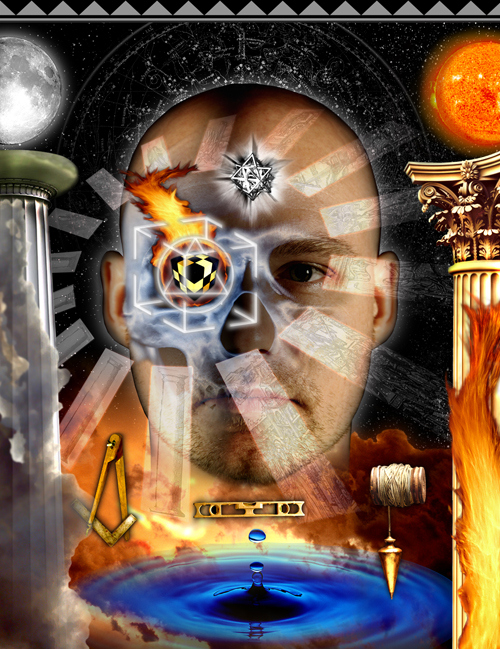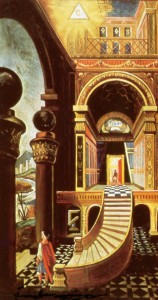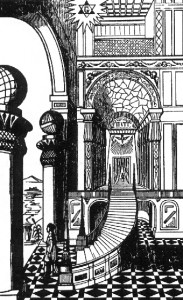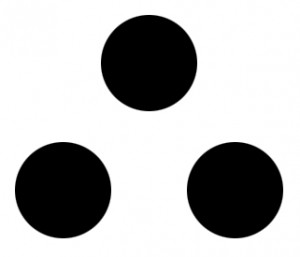A Lecture on the Second Degree of Freemasonry
On our way to the Sanctum Sanctorum, the newly made Mason undertakes a passage through what is commonly called the Middle Chamber. The reference into the middle way is through the temple of Solomon, and the pathway to the Holy of Holies, the adytum in which the Holy Ark of the covenant resides at the the Kodesh Hakodashim, or the place in which deity dwells. In that journey through the middle space, the Second degree brother is introduced to some of the more seemingly secular influenced aspects of the fraternity that begin to take on a double, or symbolic, meaning. On their surface, the basic notions of these things are obvious, but not until you start to look at them closely, at their deeper meanings, that we start to see their relationships to other more esoteric ideas. This is similar to religious traditions where withing one religious text there can be multiple layers of meaning, and multiple ways of interpretation which can lead to an allegorical, a moral, or a mystical meaning.
Indeed, as the degree is symbolically in King Solomon’s Temple, so to can it be seen as a symbolic metaphor to our own internal path, what Joseph Campbell calls the hero quest, and where you “leave the world that you you’re in and go into a depth or into a distance or up to a height.”[1]
This is not to assume that the Masonic degrees have a similar relevancy to sacred or spiritual texts, though some could argue that their significance is almost as powerful to some observants. It is a system of morality that strives to make good men better, which runs nearly in parallel with the many Volumes of the Sacred Law which seeks similar outcomes to achieve as it outlines and instructs its path to elevation. Whether its salvation or spiritual awakening the holy books seek to instruct its adherents to live better lives through their faith, the same that Freemasonry strives to through its practice – to make those good men better. In that process of making the good man a candidate for the degrees is made an entered apprentice, symbolically as he ascends Jacob’s ladder. Once at the top, he is presented a series of three groups of symbols which are set before him to become a Second Degree mason so as they may observe and contemplate them in their path of progression, their hero’s quest, to the third degree.
The story of the degree, from Duncan’s Masonic Ritual and Monitor*, picks up after the passage between the twin pillars of the degree with the conductor delivering this instruction:
Brother, we will pursue our journey. The next thing that attracts our attention is the winding stairs which lead to the Middle Chamber of King Solomon’s Temple, consisting of three, five, and seven steps.
The first three allude to the three principal stages of human life, namely, youth, manhood, and old age. In youth, as Entered Apprentices, we ought industriously to occupy our minds in the attainment of useful knowledge; in manhood, as Fellow Crafts, we should apply our knowledge to the discharge of our respective duties to God, our neighbors, and ourselves; so that in old age, as Master Masons, we may enjoy the happy reflections consequent on a well-spent life, and die in the hope of a glorious immortality.
They also allude to the three principal supports in Masonry, namely, Wisdom, Strength. and Beauty; for it is necessary that there should be wisdom to contrive, strength to support, and beauty to adorn all great and important undertakings.
They further allude to the three principal officers of the Lodge, viz.: Master, and Senior and Junior Wardens.
Let’s pause here and consider what some of the deeper meanings of these first steps infer. The first segment is fairly straight forward; with narrative telling us that the three steps allude to the three stages of human life – Youth, Manhood, and Old Age.
Youth is defined as:
Young persons, collectively.
A young person; especially, a young man.
The quality or state of being young; youthfulness; juvenility.
The part of life that succeeds to childhood; the period of existence preceding maturity or age; the whole early part of life, from childhood, or, sometimes, from infancy, to manhood.
This is a pretty straight forward idea, especially as it says to us that “we ought industriously to occupy our minds in the attainment of useful knowledge”, but how does this apply to an older initiate, someone who is no longer in his youth. Is it a wistful thought to what was achieved when younger and in still in school? Taken on a deeper level, it could allude to the idea of the degree itself, the First degree being synonymous to mean that in the first, the candidate comes to the lodge as a youth (despite his chronological or physical age) with a clean slate of perception and a clean pallet of interpretation. In a sense, he comes as blank slate to its teachings or to the ideas before him. The degree being his introduction from exterior life to interior life which ushers him both into the fraternity and into the concept of the undertaking. Pike, in the first degree lecture in Morals and Dogma, calls this the focusing of the aspirants “unregulated force” – the channel by which they constrain their previously raw, infantile state, into that of a focused and youthful aspirant no matter their age.
Next, the candidate enters into his Manhood, more literally the 2nd degree, of which the ceremony says of it “we should apply our knowledge to the discharge of our respective duties to God, our neighbors, and ourselves” which is a really active process to live by. We, in essence, are to achieve much by way of our doing, essentially, the work of our daily life towards our deity in worship and practice, our community in which we live and reside, but more specifically as we apply it to ourselves in continuing to apply what we’ve learned in our youth to this state of existence.
The Free Dictionary defines Manhood as:
1. The state or time of being an adult male human.
2. The composite of qualities, such as courage, determination, and vigor, often thought to be appropriate to a man.
3. Adult males considered as a group; men.
4. The state of being human.
In the third entry, we can take much from it beyond it simply being our middle state of being. It is in fact our ability to BE in the first place, our SELF in daily practice. Interesting as this is, the second degree in which our further education takes place is not only about the practice of our youth but also our ability to learn and apply that education to our life.
Campbell says of the age progression that “As a child, you are brought up in a world of discipline, of obedience, and you are dependant on others. All this has to be transcended when you come to maturity, so that you can live not in dependency but with self-responsible authority.”[2] This is, in essence, the heart of the three degree progression and the fundamental of the three steps – he becoming a man (or woman, respecting your discipline)!
Old age is a bit more of a troubling and complex issue. So often in modern society we look at old age as a point of retirement where work and physical activity dramatically changes or diminishes. In this description, the idea of old age holds true in that the degree says of old age that in it “we may enjoy the happy reflections consequent on a well-spent life, and die in the hope of a glorious immortality”
There are several interesting meanings we can take from this especially that it is in the degrees that these physical changes are metaphorically said to take place which can become a literal interpretation, and that once attained the Master Mason can live through them – literally to reflect on the life well spent. What’s troubling here is that the major portion of the work of the lodge is spent in the third degree and a caution must be considered so as to not see the work of the Master Mason as just one of reflection and of casual rest lest no work, as described in Manhood, be completed.
Old Age is essentially defined as ones age nearing or passing the average life span of human beings, and thus at the end of the human life cycle. In the U.S. this is considered to be 78 years old giving a distinct impression as to when one should then become a True Master. It really is at a twilight of life period, one of great age and maturity where little change and much reflection takes place. This gives us an interesting perspective on the meaning as it implies a near end of physical life period of time which squares with the degrees lesson as the period of reflection of a life well spent. We become the Master of our all, ready to pass our knowledge on to the next generation.
With this vantage, we can take pause to deeply consider that our daily working of the degrees, intrinsically, could (or should) be conducted in the 2nd state, our manhood in which we conversely learn and grow.
Symbolism of the Second Degree
Cirlot, in his Dictionary of Symbols, makes an interesting point in that the idea of progression in the stages of age is not unique to Masonry. Besides the stages themselves, the number three (3) is a representation of synthesis and unites the “solution of conflict posed by dualism.” In other words, the third object brings about balance for the first two opposing states. Think of the balance of three dots, one stacked above two.
From this point, the degree breaks off to correlate these first steps with the three principal pillars of the lodge as Wisdom, Strength and Beauty which also has an interesting Kabalistic point of reference in the three pillars that make up the structure of the tree of life. Keep in mind, the orientation assumes the viewer reverse the structure to mirror ones own standing rather than simply reflect the observer.
Wisdom, the left hand pillar of mercy, is an active pillar and representative of alchemical fire, which is the principal of spirituality, often called the pillar of Jachin. It is a masculine pillar, and relates to our mental energy, our loving kindness, and our creative inspiration as we traverse it up the Kabbalaistic tree through the Sephirot.
Strength is the right hand pillar and takes the form of severity, shaped into the alchemical symbol of water. It can represent darkness, but it is a passive symbol that is feminine in nature and called the pillar of Boaz. Upon it we find the points of our thoughts and ideas, our feelings and emotions, and the physicality of our physical experience, our sensations, each an aspect of its Cabalistic progression.
Beauty, then, takes on the role of synthesis of the two, the pillar of mildness; it is upon this pillar that the novitiate is transformed through his progressive states as he progresses. The central pillar of Beauty is representative of Jehovah, the Tetragrammaton which represents deity itself upon which our crown of being resides balanced through feeling and emotion from our foundation of justice and mercy, all of which springs from our link to the everyday world.
These aspects of the Kabbalah are not specific attributes of the study in the blue lodge, rather elements of deeper esoteric study, found more specifically in the degrees of the Scottish Rite. Because of the pillars, and their deeper symbolic meaning, it does, however, necessitate looking at them deeper to see the relationship between them as the blue lodge degrees seem to have parallels in the study of the Kabbalah – a happy accident at some time past or with purpose to link the ideas together. Wisdom, Strength, and Beauty are specific aspects of the lower three degrees and emphasized here in the first three steps into the middle chamber, necessitating their deeper esoteric study to fully grasp their broader importance.
As the degree instructs – Wisdom is to contrive, Strength is to support, and Beauty is to adorn all great and important undertakings – which are the fundamentals of the three pillars in the Kabbalaistic study.
Conversely, as the degree states, these three pillars “allude to the three principal officers of the Lodge, viz.: Master, and Senior and Junior Wardens.” and can be interpreted as such in both a micro (in lodge) fashion and in a broader macro tradition of Masonry itself – in this Kabbalaistic formulation. When the alchemical aspects of wisdom and strength are combined we can see the 6 pointed star appears, the symbol of transformation, often depicted in the conjoining of the square and compass in which Masons are instructed to square their actions and circumscribe their passions, which also corresponds to the link between the Saints Johns – the Baptist as the principal of alchemical water, and the Evangelist as the symbol of alchemical fire, both of whom have much deeper esoteric connections in Masonry. Also, the figures of the lodge leadership have a deeper connection as you begin to look at their alchemical connections too, when you look at their relationship to the Sun and moon, and the aspirant candidate as the solution of conflict, as Cirlot described, and as defined in the first degree – the three sphere aspect to balance the two of conflict.
From these short first few tentative steps, we can see that there is a wealth of Masonic symbols at hand, but we are only one third into our progression. Our next step takes us deeper into the middle chamber to its central position where we encounter an interesting juxtaposition of the physical world to our very human aspect of being through our senses.
For now, reflect a time on these first three steps and consider what comes next upon the path.
Read the series:
Part 1 – Masonic Symbolism on the Winding Staircase
Part 2 – Symbolism on the Winding Staircase – 5 steps upon the stair
Part 3 – Symbolism on the Winding Staircase – Seven the Magic Number
[1] Campbell, Joseph, “The Power of Myth”, p. 129
[2]ibid* Duncan’s Ritual Monitor is the most universal aspect of the degrees and widely available in public circulation so as to get a glimpse of the Masonic degrees. Its publication, originating in 1866 and has been has been republished many times since. It includes the three blue lodge degrees of the Ancient York Rite, and four additional advanced degrees of the York Rite.












Thanks for taking the time to write this article. The second degree has always been my favorite. One correction though, you have both jachin and boaz as being the left pillar.
Michael, thanks for the note and I’ve made the correction!
history on boaz
Greg. It as been over a year since you place this article. Not long ago I was looking for Mason Picture, and can you imagine my suprise when I seen the picture “Second degree tracing Board”. The man on the picture is almost my twin. It make me very curious where you get that picture. The funny thing also was that my faith in masonry was been question. See this made me realize that where I belong. God do work in some strange way. Never the less, do you have any information on who it maybe on the picture?
Thanks and take care Brother.
The image came from a stock image library I use. Its been so long, I’m not sure if its even up on the site anymore, but that’s where it came from. I’ve had a few people tell me that it resembles someone they know or themselves. In truth, my wife said it looks like me about 20 years ago, which may have been an unconscious decision in selecting that particular face.
Brother, this is an amazing article. Being a Pennsylvania freemason, our blue lodge doesn’t ever discuss the winding stairs, so this article is perfect. Thank you!